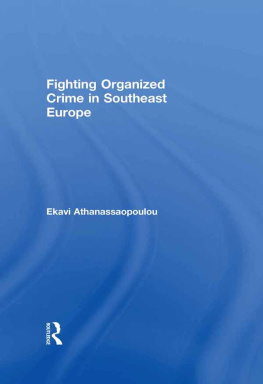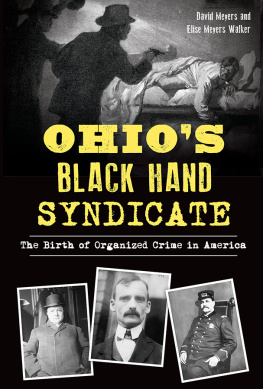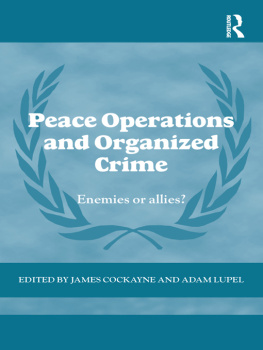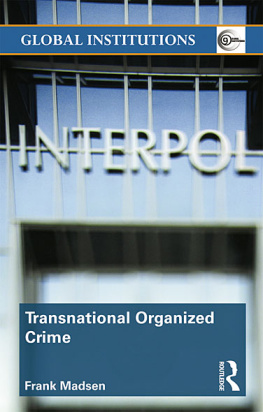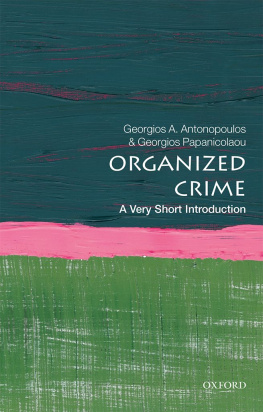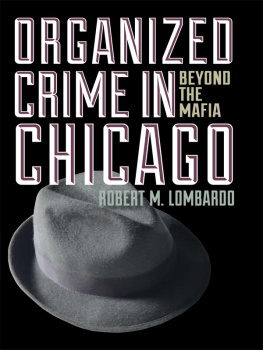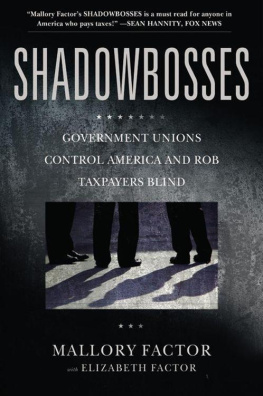Originally published in 1969 by Donald P. Cressey.
First published 2008 by Transaction Publishers
Published 2017 by Routledge
2 Park Square, Milton Park, Abingdon, Oxon OX14 4RN
711 Third Avenue, New York, NY 10017, USA
Routledge is an imprint of the Taylor & Francis Group, an informa business
Copyright 2009 by Taylor & Francis.
All rights reserved. No part of this book may be reprinted or reproduced or utilised in any form or by any electronic, mechanical, or other means, now known or hereafter invented, including photocopying and recording, or in any information storage or retrieval system, without permission in writing from the publishers.
Notice:
Product or corporate names may be trademarks or registered trademarks, and are used only for identification and explanation without intent to infringe.
Library of Congress Catalog Number: 2008006864
ISBN: 978-1-4128-0764-7 (pbk)
Library of Congress Cataloging-in-Publication Data
Cressey, Donald Ray, 1919
Theft of the nation: the structure and operations of organized crime in america
/ Donald R. Cressey.
p. cm.
Originally published: New York: Harper & Row, 1969. With new introd.
Includes bibliographical references and index.
ISBN 978-1-4128-0764-7
1. Organized crime--United States. 2. Mafia--United States. I. Title.
HV6791.C715 2008
364.1'060973--dc22
2008006864
by
Jim Finckenauer
IN THE FALL OF 1963,1 was a first-year graduate student studying sociology and criminology at New York University. Given my interest in the study of crime, I was much taken by the news coverage of the hearings, then being held in Washington, DC, by the Permanent Subcommittee of the Senate Committee on Operations, chaired by Arkansas Senator John L. McClellan. Among the witnesses appearing before the committee were Attorney General Robert F. Kennedy and a small-time hoodlum named Joseph Valachi.
Attorney General Kennedy, unlike his predecessors, had given a high priority to combating organized crime from his first days in office. And it was that attention from the very highest levels that helped stimulate the FBI's, until then, somewhat tepid interest in this problem. FBI Director J. Edgar Hoover had consistently denied for years that there was anything like a nationwide criminal cartel known as the mafia operating in the United States.
Joseph Valachi, the MeClellan committee witness, was the most prominent of the newly cultivated FBI informants developed in the early 1960s. It was Valachi, along with other sources, and most especially the critical fruits of the then just recently expanded FBI electronic surveillance (bugs and wiretaps) that not only informed Kennedy's views, but that largely shaped the McClellan hearings, and most importantly the overall picture of organized crime that emerged following those hearings.
It was this Valachi-painted and surveillance-derived picture, when combined with what had been learned from the Kefauver Committee hearings in the early 1950s, from the investigative follow-up to the aborted Apalachin, NY gathering of organized crime figures in 1957, and from a series of meetings known as the Oyster Bay Conferences in 1965-1966, that pretty much comprised the state-of-the-art knowledge of organized crime at that time.
It was also during this period (the mid 1960s) that President Lyndon B. Johnson, who had successfully defeated Republican candidate Barry Goldwater in the 1964 presidential elections, decided to form a national crime commission. Despite having won the election handily, Johnson recognized the resonance of the crime issue in the law and order campaign waged by Goldwater. The so-named President's Commission on Law Enforcement and Administration of Justice began work in 1965. A task force on organized crime was added to the various task groups of the Commission somewhat lateralbeit pretty much as a low budget afterthought.
That latter group brought in as one of its consultants, Donald R, Cressey, a professor of sociology at the University of California, Santa Barbara. Cressey's subsequent report for the task force, "The Functions and Structure of Criminal Syndicates," not only influenced specific recommendations made by the Commission in its 1967 report, but more importantly set out a view of what organized crime in the United States was like that has influenced law enforcement policies and practices, as well as research and writing on organized crime for more than forty years. And it was from his consultant's report that Cressey fashioned Theft of the Nation, first published in 1969.
At that time, I was still a graduate student (finishing a doctorate), but was also working in a research capacity for the New Jersey State Law Enforcement Planning Agency, That agency was one such body created in all states and territories following the recommendations of the aforementioned President's Crime Commission. Among the crime issues facing New Jersey at that time, perhaps not surprisingly, was organized crime. The Newark race riot had occurred only a year or two earlier, and the investigation of that riot led to disclosures about corruption and mob connections. There were also allegations of mob influence in the NJ state legislature. Organized crime was thus a hot topic. So, as past of the background research to help develop a plan for confronting organized crime in New Jersey, I carefully read Theft of the Nation, Although I was naive at that time to fully appreciate Cressey's historical and sociological analyses of the data and information available to him, I found the book to be an impressive piece of research. It was scholarly. It was well-documented. It was persuasive. But then again, I was just a relative neophyte.
Now. nearly four decades later, I am at least no longer a neophyte. Whether I am sophisticated enough to judge Cressey's analyses and conclusions will be for others to decide. What is clear to rrie is that I come to the book with different eyes than I did in 1969.1 am honored to introduce this new edition of Theft of the Nation, and given the history just outlined, not just a little bit in awe.
Several Premises
My first premise in approaching this task is that anyone who would rewrite history in the context of contemporary developments and thinking should do so only with caution. This is particularly so when it comes to rendering critical judgments:. The actions of historical figures were taken at a moment in time that was framed by the standards, experience and knowledge extant at that time. And just as people are products of their times, so too are scholarly works products of their times. Putting aside prescience and some ability to predict the future, any such work must have been based upon the state of knowledge at the particular time it was done. But just as this means we should not accept a particular historical version of some reality as the received truth, it does not mean that either the actions or the scholarship are time bound and have no relevance to the present. We have learned a great deal about organized crime in the past forty years. Keeping this in mind, it is appropriate to ask whether Cressey's book has current relevance? And if so, what is that relevance?



